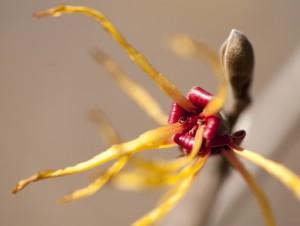Is there a Witch in Witch-hazel?
Posted in Around the Garden, What's Beautiful Now on February 15 2012, by Joyce Newman
Joyce H. Newman is the editor of Consumer Reports’ GreenerChoices.org, and has been a Garden Tour Guide with The New York Botanical Garden for the past six years.
 In the midst of winter’s blustery winds and wicked temperatures, it’s a great relief to see the warm yellow flowers of witch-hazel (Hamamelis x intermedia) brightening up the Garden path behind the Home Gardening Center.
In the midst of winter’s blustery winds and wicked temperatures, it’s a great relief to see the warm yellow flowers of witch-hazel (Hamamelis x intermedia) brightening up the Garden path behind the Home Gardening Center.
This fragrant hybrid shrub is a relative of the North American native H. virginiana, or common witch-hazel, a plant that is certainly a little magical to some. Lore suggests the common name refers to the forked twigs that were sometimes used in earlier times for “water-witching,” or dowsing to locate underground water. These native plants bloom in the fall rather than the winter, but are just as impressive.
In modern day applications, the aromatic extract of the leaves, twigs, and bark of the North American native plant is used commercially to make the astringent known as witch-hazel extract–found in medicines, eye-washes, lotions, and salves for soothing insect bites and burns.
But as monikers go, there’s nothing witchy about witch-hazel. The name probably comes from “wyche,” an old English word with a root different from that of the wicked witches we know from film and literature; it originally meant “flexible.” A few other plants share the name, including the wyche elm and the wyche alder, as well as the “wyche hazel.”


Another great place to see the witch-hazels in flower is the new Azalea Garden. This garden is home to over 60 individual plants representing 40 different cultivars.